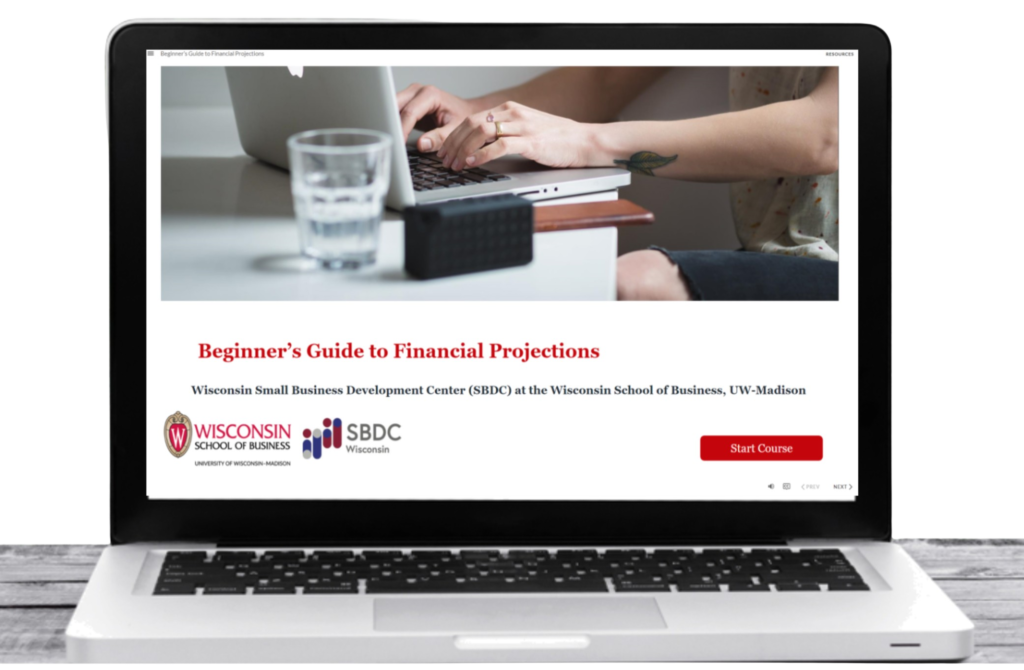Welcome to the
Beginner’s Guide to Financial Projections!
When seeking funding and/or determining the feasibility of your business idea, you will likely need financial projections. Yet developing these projections can be a complex and sometimes-overwhelming process.
This free, interactive online class is designed to help you understand what inputs you need to create projections. The course includes:
- A course overview and five content chapters
- Within the content chapters, you’ll meet our case study business owners, Mateo, who is excited to add a food cart to his already-existing catering business, and River, who is planning to open a nature-based daycare. Mateo & River will share – in their own words – how they approached building their financial projections along the way. Then, you will be able to see how their business narrative translates to numbers in the Sample Business Case Study Packet. This packet shows you the financial projection documents that River & Mateo submitted to their lenders.
- This course also includes a customized workbook that helps you apply the lessons you are learning to your own business along the way.
You can stop and start class as you need to fit your schedule. If you need to take a break, try to complete a section before doing so. Chapters 1-5 must be completed before you can access the case study review.
To get the most out of this course, complete the course workbook, view all of the videos, and take the time to understand the documents explained in the case study review section. You may find it helpful to take this course more than once to solidify your knowledge.
START HERE
Download Course Materials HERE
You will need to download two documents before you begin:
-

The Sample Business Case Study Packet shows the financial projections documents for our sample business owners – River and Mateo – who you will hear from throughout the course. In the course content, the checklist icon is used to refer to the case study packet.
 The Course Workbook gives you the opportunity to apply the concepts you’ve learned to your own business. By understanding what inputs you will need for your financial projections, you will be well on your way! In the course content, the book icon refers to relevant workbook sections.
The Course Workbook gives you the opportunity to apply the concepts you’ve learned to your own business. By understanding what inputs you will need for your financial projections, you will be well on your way! In the course content, the book icon refers to relevant workbook sections.
Once you have downloaded both documents, you can begin the course by navigating to the Course Overview tab on the red menu above, or by clicking the blue button below.
Frequently Asked Questions
This is an accordion element with a series of buttons that open and close related content panels.
What are financial projections?
Financial Projections are an estimate of future financial outcomes for a new business or a new project in an existing business.
While annual budgeting and financial planning can function like financial projections, this course focuses on financial projections that are needed for one-time, specific events (typically to secure funding). These events include:
- Starting a new business
- Purchasing an existing business
- Expanding an existing business
Who is this course for?
While any new or expanding business owner could benefit from the concepts presented in this course, many businesses participate in this process when they are seeking funding from a traditional lender.
This course was designed to support business owners at all levels of financial knowledge. Our goal is to provide you with a better understanding of the terminology and concepts associated with financial projections so that you know what information you need as “inputs” and can identify where to find that information in your business plan (or perhaps that you need to still do some research in that area).
While learning about financial projections can be valuable at any stage of business, you will learn the most from this course if you:
- Have a well-defined business model, which is a strategic plan of how your business will make money. For example, what are your revenue stream(s)? What product or service do you sell?
- Have aligned the scope and plan for your business with your personal resources
- Have a good idea of the size of your potential market
- Know your start-up costs (what you need to start or expand the business and estimated costs for those needs) and your anticipated ongoing operating costs
- Have access to historical financial statements (only for those who are looking to expand or purchase an existing business)
What if I don't know my business model yet?
There are many places you can go to begin defining your business model. A few examples include:
- Our First Steps to Starting a Business free, self-paced online course
- Our Biz Smart Sprint live virtual course (typically offered in the summer)
- The SBDC Entrepreneurial Training Program (locations across Wisconsin)
What does this course cover?
You will learn to answer these questions:
- How can I prepare to create financial projections? What information do I need to gather?
- What is some basic terminology I should understand to be more “fluent” in the language of projections?
- How do financial projections work? What are the key components?
- What can I expect when working with a traditional lender?
- What are some typical sources of funding for new businesses and expansion projections?
- What are some next steps I can take to translate my inputs into projections?
This course does not focus on any particular financial template; instead, we want to prepare you to understand what information you need to be able to work with a variety of templates and to be able to better work with service providers – such as business consultants through your SBDC network and other no-cost and paid technical service providers. At the conclusion of this course, you will have a better understanding of what you will need to be ready to create financial projections and access to a variety of resources for taking the next step.
What should I expect from this course?
This course provides a few key components to help you be successful – wherever you are in the process. These include:
- The core course content provides you with an overview of what financial projections are, key terminology that will help you understand the inputs and components of financial projections, and related topics, such as: working effectively with a lender and resources for your next steps. Within the course content, each section includes:
- Examples from two sample businesses to help you understand how the concepts apply to real-life situations
- An interactive lesson
- An opportunity to check your knowledge at the end of each chapter with a few quiz questions
- A downloadable workbook that helps you apply the concepts to your business. Throughout the class, whenever you see a workbook prompt, you will know that the workbook has additional opportunities to learn or consider your own business.
- A sample business case study packet to show you the financial projection statements and documents our sample business owners submitted to their lenders
This course includes a lot of information and terminology that may be new to you. You may find it helpful to view the whole course once to get an overview, then go back through to dive more deeply into the sample business examples and download and complete the workbook for your own business as you learn more through research and experience.
Sections of the Course
- Chapter 1: Introduction to projections and key terminology
- Chapter 2: Your Business Model
- Chapter 3: Predicting Revenue
- Chapter 4: Estimating Costs
- Chapter 5: Common sources of funding & lender expectations
- Case Study Review: Putting the Pieces Together
Will I receive anything for completing this course?
This course is designed to help you in your understanding of terminology and concepts surrounding financial projections. Completion of the course workbook will help you establish many of the key inputs you will need for input into a financial projections template.
Additionally, there is a certificate of completion available if you complete the entire course.

This course – being offered to you at no charge – was developed by the Wisconsin Small Business Development Center (SBDC) at UW-Madison and has received financial support from Federal Community Project Funds & Associated Bank.
This course is designed to help you learn fundamental terminology and concepts that will help you understand and clarify the numerical inputs you will need for projections and how those inputs connect with your business plan. By developing this foundational knowledge, we believe you have the tools to be successful regardless of the financial projections template you use!
Course overview
Start here! The course overview helps you understand more about what projections are, how you can best prepare yourself to create financial projections, and what to expect from the course itself.
Chapter 1: Introduction to Financial Projections
In Chapter 1, you'll learn when financial projections are needed, who utilizes financial projections, and some basics about relevant financial statements (profit and loss, balance sheet, and the cash flow statement). You'll also learn about the sources and uses of funds statement.
Chapter 2: Business Model
In Chapter 2, you'll discover how your business model serves as the basis for your financial projections and what information you need to create projections. You'll also learn some common tools for documenting your business model.
Chapter 3: Revenue Forecasting
In Chapter 3, you'll learn how to make reasonable estimates about the income you can expect based on your revenue stream(s), unit(s) of sale, and estimated market size and share. Additionally, this chapter explores how to approach pricing for your business.
Chapter 4: Estimating Costs
In Chapter 4, you'll review common costs you may experience in your business, including startup costs for a new or expanding business, operating expenses that help keep your business running smoothly, cost of goods sold for creating your product/service, and labor costs. You'll also think about your own income needs as the business owner in terms of your goals and projections.
Chapter 5: Funding
In Chapter 5, you'll learn more about the most common sources of small-business funding and dive into what a formal lender would expect from you in order to secure a business loan.
Case Study Review
The Case Study Review is where everything comes together! Here, you will have the opportunity to see how River and Mateo put everything they learned together into their financial projections documents.









